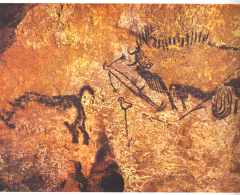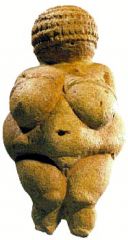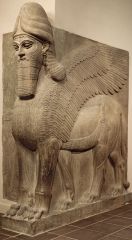![]()
![]()
![]()
Use LEFT and RIGHT arrow keys to navigate between flashcards;
Use UP and DOWN arrow keys to flip the card;
H to show hint;
A reads text to speech;
7 Cards in this Set
- Front
- Back

optical
|
• Definition: what is seen is depicted in the artwork
• Example: The Stele of Hammurabi • Forshortening—showing object at an angle to suggest depth o Shamash’s headdress is in a side view, showing only 4 horns, rather than all 8 o Shamash’s beard has diagonal lines showing recession • C. 1780 BCE; 7’4”; Iran |
|

conceptual
|
• Definition—shows not necessarily what is seen, but all of the information about the subject (can include composite perspective)
• Example: The Hunt Narrative at Lascaux • Twisted perspective—the head of the bull is in profile, but both of the horns are seen o Wouldn’t see both horns from profile in real life, but use twisted perspective to inform the viewer of all aspects of the bull • C. 15,000-13,000 BCE; Bison 3’8”; Lascaux, France |
|

|
• Title: The Venus of Willendorf
• Date: c. 28,000-25,000 BCE • Artist: unknown • Country: Willendorf, Austria • Medium: Limestone sculpture • Dimensions: 4.25’ • Significance: Most prehistoric sculptures were of animals, but if human, they were of women o No facial detail, focus on exaggerated breasts suggest image of fertility |
|

|
• Title: Landscape with Volcano
• Date: c.6150 BCE • Artist: unknown • Country: Catal Hoyuk, Turkey • Medium: wall painting • Dimensions: not stated • Significance: world’s first landscape painting (natural setting w/o narrative context) o Devoid of both humans and animals |
|

|
• Title: Lamassu
• Date: c. 720-705 BCE • Artist: unknown • Country: Citadel of Sargon II, Dur Sharrukin in the Assyrian Empire (Iraq) • Medium: Limestone • Dimensions: 13’10” • Significance: Guard the gate of the citadel o Composite perspective 5 legs: 2 from front view, 3 side view |
|

|
• Title: Eshnunna Statuettes
• Date: c. 2,700 BCE • Artist: unknown • Country: Eshnunna (Iraq) Sumerian • Medium: Gypsum inlaid with shell and black limestone • Dimensions: 2’6” • Significance: buried beneath temple in “waiting rooms” to pray constantly o Wide eyes and crossed hands in prayer |
|

|
• Title: Victory Stele of Naram-Sin
• Date: c. 2254-2218 BCE • Artist: unknown • Country: Akkadian Empire in Iraq • Medium: Pink sandstone • Dimensions: 6’7” • Significance: narrative of one of Naram-Sin’s battle victories o Hierarchy of scale—Naram-Sin is the largest and highest in landscape reaching towards the heavens o Horned helmet—divinity |

